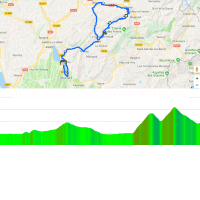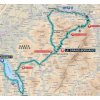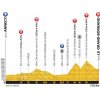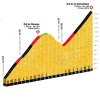Following a flat warm-up the route starts to point uphill at kilometre 12. The first QOM points are up for grabs at Col de Bluffy, an 1.5 kilometres hill at 5.5% with its crest after 19 kilometres. And on it goes to the Côte de Saint-Jean-de-Sixt. At kilometre 38 La Course travels over the top of this 5.5 kilometres climb with an average gradient of 4.9%.
A stretched-out descent leads to Bonneville, where the route enters a flat section of about 18 kilometres to the foot of the Col de Romme. From this moment on it’s all systems go. The Romme is an 8.8 kilometres climb with an average gradient of 8.9%. The first 3 kilometres are tough as these are averaging 9.8%. The seventh kilometre is another tricky section with an average slope of 10%. The summit is not really the summit as the climb goes on as a false flat for around 2 kilometres before a 4 kilometres drop leads to the the base of the Col de la Colombière.
De Col de la Colombière is a 7.5 kilometres ascent at 8.5%. In comparison, the first 2 kilometres are the easiest part of the climb, but after this the gradients are 9% or more. The sixth and the seventh kilometre are steepest as these are averaging 10.2% and 9.7%. After cresting the women plunge down a 13 kilometres descent into Le-Grand Bornand, where the race ends with a false flat of 1.5 kilometres.
La Course’s route overlaps the Tour de France’s 10th stage. After Bonneville, with 53.5 kilometres to go, both routes are identical.
Read also: results/race report 2018 La Course.
La Course 2018: Route maps, height profiles, and more
Click on the images to zoom









